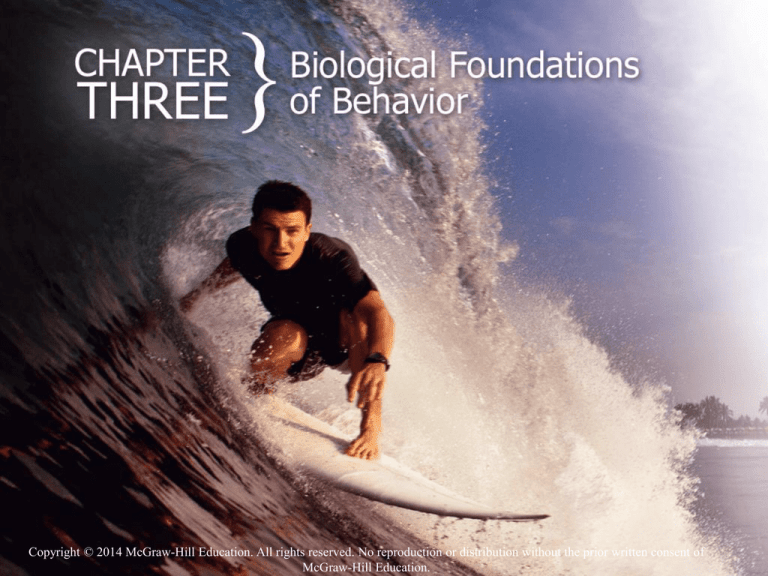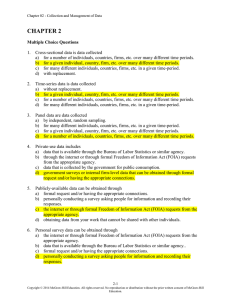
Copyright © 2014 McGraw-Hill Education. All rights reserved. No reproduction or distribution without the prior written consent of
McGraw-Hill Education.
CHAPTER PREVIEW
Nervou
s
System
Neuron
s
Damag
e,Plasti
city,
And
Repair
Brain
Genetic
s
And
Behavi
or
Endocrin
e
System
Health
And
Wellnes
s
Copyright © 2014 McGraw-Hill Education. All rights reserved. No reproduction or distribution without the prior written consent of
McGraw-Hill Education.
3-2
NEUROSCIENCE
Study of the body’s electrochemical communication circuitry
Copyright © 2014 McGraw-Hill Education. All rights reserved. No reproduction or distribution without the prior written consent of
McGraw-Hill Education.
3-3
NERVOUS SYSTEM
• Complex
• Integrated
• Adaptable (plasticity)
• Electrochemical transmission
Copyright © 2014 McGraw-Hill Education. All rights reserved. No reproduction or distribution without the prior written consent of
McGraw-Hill Education.
3-4
NERVOUS SYSTEM: PATHWAYS
Nerves carry information
afferent
Brain
Body
efferent
Which type connects with skin?
With muscle?
Copyright © 2014 McGraw-Hill Education. All rights reserved. No reproduction or distribution without the prior written consent of
McGraw-Hill Education.
3-5
NERVOUS SYSTEM: DIVISIONS
NERVOUS SYSTEMS (NS)
• Central (CNS)
– brain and spinal cord
• Peripheral (PNS)
– Somatic NS
• sensory nerves
• motor nerves
– Autonomic NS
muscular activity
internal organs
• sympathetic NS
arouses
• parasympathetic NS
calms
Copyright © 2014 McGraw-Hill Education. All rights reserved. No reproduction or distribution without the prior written consent of
McGraw-Hill Education.
3-6
NERVOUS SYSTEM - CELLS
• Glial Cells
– provide support and nutrition
• Neurons (about 100 billion in brain)
– information processing
• computing & communicating
– mirror neurons (in primates)
• imitation, social perception
Copyright © 2014 McGraw-Hill Education. All rights reserved. No reproduction or distribution without the prior written consent of
McGraw-Hill Education.
3-7
NEURONS: STRUCTURE
Cell Body
Dendrites
Axon
Impulse
Myelin Sheath
Copyright © 2014 McGraw-Hill Education. All rights reserved. No reproduction or distribution without the prior written consent of
McGraw-Hill Education.
3-8
NEURAL IMPULSE
• Negatively + Positively Charged Ions
• Polarization (Imbalance in Charges)
• Resting Potential
Copyright © 2014 McGraw-Hill Education. All rights reserved. No reproduction or distribution without the prior written consent of
McGraw-Hill Education.
3-9
NEURAL IMPULSE
• Semipermeable Membrane
• Ion Channels
• Depolarizaton (Ion channels open)
• Threshold
• Action Potential
(Ion exchange sweeps
along length of axon)
• All-or-None Principle
Copyright © 2014 McGraw-Hill Education. All rights reserved. No reproduction or distribution without the prior written consent of
McGraw-Hill Education.
3-10
SYNAPSES AND NEUROTRANSMITTERS
Synaptic Transmission
• Electrical impulse is
converted into a
chemical signal.
Synapse
• Axon vesicle releases
neurotransmitter into
gap.
Neurotransmitters
Vesicle
• Dendrite receptor site
detects
neurotransmitter
Synaptic Gap
Receptor Site
Copyright © 2014 McGraw-Hill Education. All rights reserved. No reproduction or distribution without the prior written consent of
McGraw-Hill Education.
3-11
NEUROTRANSMITTERS
Neurotransmitters carry information across the synaptic gap to
the next neuron.
– Acetylcholine
• muscle actions, learning, memory
• black widow venom ↑ Ach levels
• Botox (botulin) ↓ Ach levels
• Alzheimer’s disease: ↓ Ach levels
– GABA
• Anxiety: ↓ GABA levels
Copyright © 2014 McGraw-Hill Education. All rights reserved. No reproduction or distribution without the prior written consent of
McGraw-Hill Education.
3-12
NEUROTRANSMITTERS
• Glutamate
– excitatory
– learning and memory
– involved in many psychological
disorders
• Norepinephrine
– stress and mania: ↑ norepinephrine
levels
– depression: ↓ norepinephrine levels
– regulates sleep states in conjunction
with Ach
Copyright © 2014 McGraw-Hill Education. All rights reserved. No reproduction or distribution without the prior written consent of
McGraw-Hill Education.
3-13
NEUROTRANSMITTERS
• Dopamine
– voluntary movement
– reward anticipation
– stimulant drugs: activate
dopamine receptors
– parkinson’s disease: ↓
dopamine levels
– schizophrenia: ↑ dopamine
levels
Copyright © 2014 McGraw-Hill Education. All rights reserved. No reproduction or distribution without the prior written consent of
McGraw-Hill Education.
3-14
NEUROTRANSMITTERS
• Serotonin
– regulation of sleep, mood,
attention, learning
– depression: ↓ serotonin levels
– Prozac: ↑ serotonin levels
• Endorphins
– natural opiates
– mediate feelings of pleasure and
pain
Copyright © 2014 McGraw-Hill Education. All rights reserved. No reproduction or distribution without the prior written consent of
McGraw-Hill Education.
3-15
NEUROTRANSMITTERS
• Oxytocin
– both a hormone and a
neurotransmitter
– related to onset of lactation in
new mothers
– related to attachment/emotional
bonds
• Note: Drugs can interfere with
neurotransmitters.
– mimic or enhance NT effects
– block effects of NT
Copyright © 2014 McGraw-Hill Education. All rights reserved. No reproduction or distribution without the prior written consent of
McGraw-Hill Education.
3-16
NEURAL NETWORKS
• Interconnected pathways of
nerve cells
• Integrate sensory input
and motor output
• Develops across the years
• Where a given piece of information is stored:
– not in a lone neuron or connection
– but spread over multiple connections and neurons
Copyright © 2014 McGraw-Hill Education. All rights reserved. No reproduction or distribution without the prior written consent of
McGraw-Hill Education.
3-17
STUDYING THE BRAIN
• Brain Lesioning
– naturally occurring or induced
• Electrical Recording
– electroencephalograph (EEG)
– single-unit recording
Copyright © 2014 McGraw-Hill Education. All rights reserved. No reproduction or distribution without the prior written consent of
McGraw-Hill Education.
3-18
BRAIN IMAGING
• X-Ray
• CT Scan
• PET
• MRI
• fMRI
Copyright © 2014 McGraw-Hill Education. All rights reserved. No reproduction or distribution without the prior written consent of
McGraw-Hill Education.
3-19
HINDBRAIN
• Parts of the Brain
– Brainstem
• medulla – control breathing,
regulate reflexes
• pons – sleep and arousal
– Cerebellum
• motor coordination
Copyright © 2014 McGraw-Hill Education. All rights reserved. No reproduction or distribution without the prior written consent of
McGraw-Hill Education.
3-20
MIDBRAIN
• Substantia Nigra
• Parkinson’s Disease
• Reticular Formation
• Stereotyped Behavior
Patterns (like walking)
Copyright © 2014 McGraw-Hill Education. All rights reserved. No reproduction or distribution without the prior written consent of
McGraw-Hill Education.
3-21
FOREBRAIN
• Limbic System
– memory and emotion
• amygdala
– discrimination of
objects needed for
survival
– emotional awareness
and expression
• hippocampus
– Formation and recall
of memories
• Thalamus
– relay station for much
sensory information
Copyright © 2014 McGraw-Hill Education. All rights reserved. No reproduction or distribution without the prior written consent of
McGraw-Hill Education.
3-22
FOREBRAIN (CONT’D)
• Basal Ganglia
– coordination of voluntary
movements
• Hypothalamus
– eating, drinking, sexual behaviors
– regulate body’s internal state
– emotion, stress, reward
Copyright © 2014 McGraw-Hill Education. All rights reserved. No reproduction or distribution without the prior written consent of
McGraw-Hill Education.
3-23
THE BRAIN IN DIFFERENT SPECIES
What brain structures are similar across species?
How is the brain suited to each species?
Copyright © 2014 McGraw-Hill Education. All rights reserved. No reproduction or distribution without the prior written consent of
McGraw-Hill Education.
3-24
CEREBRAL CORTEX
• Neocortex: Outermost Layer
• Four Lobes:
– occipital (vision)
Parietal
Frontal
– temporal (hearing, language
processing, memory)
– frontal (intelligence,
personality, voluntary
muscles)
– parietal (spatial location,
attention, motor control)
Occipital
Temporal
Copyright © 2014 McGraw-Hill Education. All rights reserved. No reproduction or distribution without the prior written consent of
McGraw-Hill Education.
3-25
PROCESSING HUMOR
Temporal – Occipital – Parietal Junction(TOPJ)
– detecting & resolving conflict
Copyright © 2014 McGraw-Hill Education. All rights reserved. No reproduction or distribution without the prior written consent of
McGraw-Hill Education.
3-26
SOMATOSENSORY, MOTOR, AND
ASSOCIATION CORTEX
• Somatosensoy Cortex (in parietal lobe)
– body sensations / touch
• Motor Cortex (in frontal lobe)
– voluntary movements
– point-to-point mapping
• Association Cortex (75% of cortex)
– not sensory or motor, but associations
between
Copyright © 2014 McGraw-Hill Education. All rights reserved. No reproduction or distribution without the prior written consent of
McGraw-Hill Education.
3-27
SPLIT-BRAIN RESEARCH
Corpus Callosum
large bundle of axons that connects the two hemispheres of the
brain
W.J., the Split Brain Patient
Copyright © 2014 McGraw-Hill Education. All rights reserved. No reproduction or distribution without the prior written consent of
McGraw-Hill Education.
3-28
HEMISPHERES OF THE CORTEX
Hemispheric Specialization of Function
• left hemisphere
- verbal processing, speech,
grammar
• Broca’s Area
• Wernicke’s Area
• right hemisphere
- spatial perception,
visual recognition,
emotion
Copyright © 2014 McGraw-Hill Education. All rights reserved. No reproduction or distribution without the prior written consent of
McGraw-Hill Education.
3-29
HAPPY BRAINS?
• Happiness: Prefrontal Lobe Asymmetry
– Positive emotional responses
• More left prefrontal lobe activity
– Negative emotional responses
• More right prefrontal lobe activity
• Biofeedback
• Mindfulness (Awareness) Meditation
Copyright © 2014 McGraw-Hill Education. All rights reserved. No reproduction or distribution without the prior written consent of
McGraw-Hill Education.
3-30
ENDOCRINE SYSTEM
Set of glands
{
pituitary, thyroid, parathyroid,
pancreas, adrenal, ovaries, testes
that regulate the body by
{
secreting hormones chemical messages
into the bloodstream relatively slow
{ communication system
interconnected with the nervous system
Copyright © 2014 McGraw-Hill Education. All rights reserved. No reproduction or distribution without the prior written consent of
McGraw-Hill Education.
3-31
BRAIN DAMAGE AND PLASTICITY
• Recovery from brain damage depends on
– age of the individual
– extent of the damage
• Repairing the damaged brain
–
–
–
–
collateral sprouting
substitution of function
neurogenesis
brain tissue grafts
Copyright © 2014 McGraw-Hill Education. All rights reserved. No reproduction or distribution without the prior written consent of
McGraw-Hill Education.
3-32
GENETICS AND BEHAVIOR
• Chromosomes, Genes, and DNA
• Human Genome Project
• Dominant-Recessive Genes Principle
• Molecular Genetics
• Selective Breeding
• Behavior Genetics and Adoption
Studies
Copyright © 2014 McGraw-Hill Education. All rights reserved. No reproduction or distribution without the prior written consent of
McGraw-Hill Education.
3-33
GENES AND THE ENVIRONMENT: GENETIC EXPRESSION
Genotype
genetic heritage
+ Effects of experience
environment alters how genetic traits develop
= Phenotype observable characteristics
both physical & psychological
Copyright © 2014 McGraw-Hill Education. All rights reserved. No reproduction or distribution without the prior written consent of
McGraw-Hill Education.
3-34
BIOLOGICAL FOUNDATIONS AND
HEALTH AND WELLNESS
• Stressors
circumstances and events that
threaten individuals and/or tax their
coping abilities
• Stress
our response to those stressors
• Causes/Effects of Acute and Chronic
Stress
Copyright © 2014 McGraw-Hill Education. All rights reserved. No reproduction or distribution without the prior written consent of
McGraw-Hill Education.
3-35
CHAPTER REVIEW
• Describe the parts and functions of the nervous system.
• Explain what neurons are and how they process information.
• Identify the brain's levels, structures and functions.
• State what the endocrine system is and how it affects
behavior.
• Describe the brain's capacity for recovery and repair.
• Explain how genetics increases our understanding of behavior.
• Describe the role of the biological foundations of human
psychology in the body's stress response.
Copyright © 2014 McGraw-Hill Education. All rights reserved. No reproduction or distribution without the prior written consent of
McGraw-Hill Education.
3-36






